About 10 years ago, when I was living in Mexico, I went to a party at a beach house that belonged to a friend. It was an overcast afternoon on the Pacific Coast, but there’s a certain moment at the end of the day when the sun dips under the clouds and floods everything in light. It was then that we all saw what wasn’t visible before: a mansion, in the distance across the bay, sitting alone on its own beach, with a blue dome and fiery orange walls suddenly glowing in the dark forest that surrounded it. Someone said it had been built by the billionaire corporate raider Sir James Goldsmith in 1989. There were zebras and African antelope on the grounds; Ronald Reagan and Henry Kissinger had both been guests.
“Who’s there now?” I asked.
“It’s a hotel,” someone else said, adding I could stay there too if I wanted.
That kind of ostentatious luxury felt a little too much like Pablo Escobar, the Colombian drug kingpin, for me at the time. But I am also a curious person, who in the last decade has watched the rise of a billionaire class that vanishes into retreats just like that one. I’ll even admit to fantasizing about what it would be like to step into that “Great Gatsby” universe that exists parallel to our own, sometimes so close that it can be seen across the bay — a blue dome illuminated like a light blinking in the distance. Would it be what I imagined? After pondering it for years, last spring I made reservations to see how the billionaire once lived and learn a little bit about him.
Goldsmith’s 1997 obituary in The New York Times describes him as “a flamboyant British-French financier who maintained three families, homes in four countries and used his billions to fight the European Union.” He died at age 64 in Spain of a heart attack. It was a sudden end to a contentious life, which he first dedicated to corporate raiding against companies like Goodyear, then to politics, when — presaging Brexit by about two decades — he formed his own political party whose sole objective was a referendum on Britain’s future in the European Union. Along the way, he bought two properties in Mexico: Cuixmala, the mansion I saw on the coast in the state of Jalisco, and Hacienda de San Antonio, a former coffee plantation from the 19th century in the nearby state of Colima.
“He was one of a kind,” said Alix Marcaccini, Goldsmith’s daughter with his second wife, Ginette Lery, who runs both estates these days and whose memories of her…
Click Here to Read the Full Original Article at NYT > Travel…
